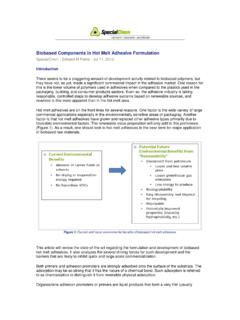Transcription of THE ROLE OF DESICCANT IN INSULATING GLASS
1 1 THE ROLE OF DESICCANT IN INSULATING GLASSTHE ROLE OF DESICCANT IN INSULATING GLASS ~ DavisonIGMAE ducational SeminarLas Vegas, NV September 18 & 19, 2006 IGMAE ducational SeminarLas Vegas, NV September 18 & 19, 2006 Presented by Steve Meisel Prepared by Dr Fritz KilthauTJ_Union Pres2 Agenda The functions of desiccants in INSULATING GLASS Types of desiccants (MS, SG) Selection of suitable desiccants Correct handling of the DESICCANT during INSULATING GLASS manufacture Quality Control/questions to ask DESICCANT in INSULATING GLASS - a review DESICCANT MATRIX TJ_Union Pres3 Functions of the DESICCANT in INSULATING GLASS Wet air trapped in IG Condensation at low temperatures Function #1.
2 Drying of the moisture trappedduring manufacture of the IG unitTJ_Union Pres4 PACKAGING WEATHER Sealing an IG unit alone does NOT eliminate moisture, but ratherSEALS MOISTUREInto the IGTJ_Union Pres5 All sealants allow moisture to permeate through the barrier at some MVTR CBA Testing-Uptake of the water vapor diffusingthrough the edge seal of the IG unit during its period of use-Keep the trapped-in air / gas dryFunctions of the DESICCANT in INSULATING GlassFunction #2:TJ_Union Pres6 Sealants / Muntin bars / GLASS cleaners / Corner pieces / Polymeric Spacers Fogging : Condensation of the off-gassed organics in the IG unit - Coated GLASS Canadian Fog Test- Uptake of organic vaporsFunctions of the DESICCANT in INSULATING GlassFunction #3:TJ_Union Pres7 Types of Desiccants: Silica Gel SiO2 structure Highly porous Non-uniform pore sizes:Ranging from 20 to 200 ngstromsREM photograph of a Silica Gel in 15000X magnificationTJ_Union Pres8 Types of Desiccants: Zeolites (Molecular Sieves) Crystalline Highly porous crystals Uniform pore sizes:3 ngstr m (3 x 10-10 m)10 ngstr m(10 x 10-10 m) REM photograph of a 3 -MS in 15000X magnificationTJ_Union Pres9 Dependent on the gases/vapors in the INSULATING GLASS .
3 Water vapor should be adsorbed Air (nitrogen/oxygen) should NOTadsorbed Argon/Xenon should NOTbe adsorbed Solvents/Plasticizers should be adsorbedSelection of Suitable DesiccantsTJ_Union Pres10 Selection of Suitable Desiccants:Cause of IG Unit Deflection Temperature variation Atmospheric pressure variation Difference in height between manufacture and installation Adsorption of the trapped moisture Adsorption of air (nitrogen/oxygen) or Argon/Xenonpin< poutpin= poutpin> poutTJ_Union Pres11 Selection of Suitable Desiccants:Impact of IG Unit Deflection Distortion of reflection image Reduced thermal conductivity - comfort and energy Increased stress of the edge seal, faster aging, higher water vapor transmission rate, reduced IGU life-times Danger of GLASS breakage - particularly smaller unitspin< poutpin= poutpin> poutTJ_Union Pres12 Selection of Suitable DesiccantsTJ_Union Pres13 Selection of Suitable DesiccantsAdsorption Properties In IGU ConditionsH2ON2O2 Solvents3 Ayesnonono4 Ayesyesyesno10 AyesyesyesyesSilica GelnononoyesTJ_Union Pres14 Correct Handling of the DesiccantTJ_Union Pres15 Correct Handling of the DESICCANT During IG ManufactureStorage Under roof Dry Bag/Super Sack.
4 No exposure to UV radiation Storage time (on packaging: date of manufacture)Drum:max. 4 yearsBag:max. 1 yearBag-in-Box: max. 1 yearSuper Sack: max. years TJ_Union Pres16 Square Wave Diffusion ModelDriver: High affinity of zeolite for watertimehumiditytimehumidityactive zeolite particlewater saturated zeolite particleOpen Drum/Bag timeCorrect Handling of the DESICCANT Water Absorption CapacityTJ_Union Pres17 Delta-T TestPrinciple: Active MS in water: Heat released leads to a temperature rise (Delta-T) Delta-T test is an easy, but rough test to check on the activity of the desiccantControl of the Activity of the DESICCANT Before UseTJ_Union Pres18 Supply drum at LISEC filling machineIn the case where the supply drum is filled from bags, the drum should be cleaned from time to time!
5 Correct Handling of the DESICCANT During IG ManufacturePrevention of dust!TJ_Union Pres19 DESICCANT Recommendation Based on Sealant Configuration Hot Melt Butyl3A or SiO2 Blend Polyurethane3A or SiO2 Blend PolysulfideSiO2 Blend PIB/PU3A or SiO2 Blend PIB/PSSiO2 Blend or 3A PIB/SiliconeSiO2 Blend or 3 ATJ_Union Pres20 Desiccation Loss in Hanging SpacersTJ_Union Pres21 Influencing Parameters: Perforation of the spacer bar Number of filled profile sides Spacer Size DESICCANT type Gas filling Temperature at Manufacture Relative Humidity at ManufactureHang Time StudiesTJ_Union Pres22 Supplier Quality Control Adsorption Capacity Gas Desorption Dust Particle Size Packaging Technical Support - Lifetime estimations, trouble shooting, hang time ShippingTJ_Union Pres23 Questions to Ask When Comparing Desiccants At what relative humidity and temperature is water capacity measured?
6 When comparing desiccants what is the density? - manufacturers filling by volume Size vs. spacer opening - Will it fill correctly? Is material low deflection? ISO 9000TJ_Union Pres24 Properties of a Desiccated Matrix Adsorb Moisture. No off-gassing. No adsorption of Argon, Nitrogen, Oxygen. Adhesion to the U-channel spacer. Pumpability. Spreadability - Aesthetics. UV Pres25spacer barPrimary SealLitedesiccantSecondary SealantLitespacer polymer withdesiccantPrimary SealantSecondary SealantConventionalInsulating GlassIntercept Loose Fill or MatrixTJ_Union Pres26 Functionality1. Drying the unit down initially after manufacture. Typically only requires less than of DESICCANT .
7 Units dry down to -90 F in 18 Adsorbing moisture that permeates through the sealant over the lifetime of the insulted GLASS unit. Dependent on MVTR of sealants, sealant application and Adsorbing off gassed organics from desiccated matrix, sealants, Pres27 Types of DESICCANT Matrix MaterialsHot Applied SystemsRequires Hot Melt shelf Cure times - Adhesion properties are constantCold Applied SystemsDoes Not require Hot Melt material - Chemically cures - Adhesion properties improve with shelf Applied SystemsHybrids of the AboveTJ_Union Pres28 Types of DESICCANT Matrix MaterialsHOT APPLIED (Over 200 F) ADCOB ostikGrace FullerWARM APPLIED (~ 160 F) FullerAMBIENT APPLIED (Room Temperature)PRC DesotaTJ_Union Pres29 Application Rates How Much do I use?
8 Questions to ask yourself - How Long do I want my IGU to last? What is the MVTR of my sealant? Is that MVTR result relevant to my sealant application? Have I taken into account manufacturing, Pres30 Application RatesOnce questions have been answered Calculation - Assumes perfect manufacturing, no elongation of sealant due to deflection. CBA testing - Really a sealant test Comparison to historical data/loadingsTJ_Union Pres31 Application RatesEquivalent loading of rectangular spacer Allmetal 1/2 std spacer. Typical IGU size 3x5 foot with 2 side fill rate estimate of 75% sieve. x x 8ft = grams of DESICCANT in a traditional unitEquivalent loading of DESICCANT Matrix with 57% sieve with four side filling.
9 X x 16ft = of desiccantEquivalent Loading of same unit with a DESICCANT matrix having 50% sieve and a 4 gram recommendation 4g x x 16ft = 32 grams of desiccantTJ_Union Pres32 Application RatesIGMA FIELD CORRELATION STUDIES10 Year Data: Class CBA failures15 year Data: Class CBA failuresTJ_Union Pres33 Quality ControlsSupplier Checks -Adsorption CapacityAdhesion Slump TestingMelt IndexViscosityGrit TestUV Testing - Stability and OffgassingTJ_Union Pres34 Quality ControlsManufacturers Controls/ChecksNo activity test like loose fill(EXCEPTION PRC)Application Rate - Measure on routine Basis(Equipment now available to lay down to the .1g)Clean spacerHang times No more than Four hoursTJ_Union Pres35 Conclusions Desiccants have three functions 1)Adsorbing the moisture included during the manufacture of the IGU2) Second most important is to adsorb any off-gassed organics WITHOUT causing deflection3) Adsorb moisture that permeates through the seal There are three commercially applicable desiccants available1) 3 2) 3 /10 Blend3) 3 /Silica BlendTJ_Union Pres36 Conclusions When you purchase DESICCANT matrix you are purchasing adsorption capacity - Ask your supplier how much DESICCANT is included.
10 Then ask your supplier s competition Different types of adsorbent used in DESICCANT matrix materials. No Real Easy Test - Ask for Certificate of Analysis. How Long do you want your IGU to last -reinvestigate your application ROLE OF DESICCANT IN INSULATING GLASSTHE ROLE OF DESICCANT IN INSULATING GLASS ~ DavisonQuestions?Questions?







